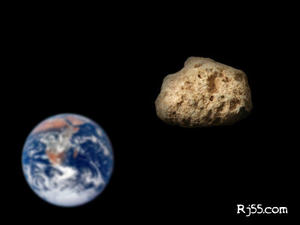Planetary securityScientists: Only nukes can stop planet-threatening asteroids
A new report by the U.S. National Research Council (NRC) says that the United States is not doing enough to protect itself – and the world – from Near Earth Objects (NEOs); the panel says that the only hope humanity has to against the larger asteroids – those bigger than 1 km; if they hit Earth, they would release energies in the hundred-thousand-megaton range – is to use nuclear weapons to try and push them off course

Artist conception of earth-bound asteroid // Source: blog.rj55.com
We wrote the other day that top American researchers have warned that the U.S. government’s efforts to prevent global apocalypse caused by meteor strike are inadequate. The scientists add that nuclear weapons are the only practical means of defense against large, planet-threatening sized asteroids.
In a new report, the U.S. National Research Council (NRC) says that Near Earth Objects (NEOs) fall into three classes. First and most terrible are large NEOs bigger than 1 km which would release energies in the hundred-thousand-megaton range — more than a global nuclear war, and with similarly catastrophic consequences for human civilization or even survival. NASA has got most of these NEOs logged in its databanks, but not all — there are likely to be a few on orbits which only bring them within observation at very long intervals.
Apart from planet-destroying big asterids like these, however, there are also a lot of quite hefty space boulders, snowballs. Etc. in the 140 m+ size range. These, owing to their terrific speed, would tend to cause destruction in the hundred-megaton range on impact — equivalent to a limited nuclear bombardment.
Lewis Page writes that NASA was instructed by the U.S. Congress to log 90 percent of these medium-sized NEOs by 2020, and, according to the National Research Council analysts, this is not going to happen as things stand — in large part because the politicians did not assign any extra funds and the administration has asked for none. The $4 million per annum the United States currently spends on sky-search activities is seen as inadequate.
Page notes that, that said, the NRC’s new report offers some alternative ways ahead which could see most of the threatening space objects spotted — either on time by 2020 using an expensive space-based telescope system, or taking a bit longer using cheaper ground instruments. The scientists also say that NASA should start scanning for smaller, 30-50 meter sized objects, as these would still be very destructive if they hit in a populated area.
This much had already been mostly stated in a preliminary report released last year, but the NRC researchers have now gone further and taken a look at the various tactics humanity might use in the event of a dangerous NEO being detected. There are many of these, some of them quite delicate and refined — using the gravitational pull of a spacecraft’s own mass to minutely drag an asteroid off course, for instance.
“Slow push/pull” methods like these are practical, according to the NRC, only for smaller NEOs and “would likely require decades of warning.” Even “kinetic” plans, in which a spacecraft crashes into an asteroid, would only work on less potent medium-to-small size threats, and again “may require decades of warning.”
In the current state of human technology, the NRC warns, the only way to be sure is to use nuclear weapons to push these threat out of orbit: “Nuclear explosions are the only current, practical means for dealing with large NEOs (diameters greater than 1 kilometer) or as a backup for smaller ones if other methods were to fail.”
Page notes that if this is indeed the case, then the current plans by President Obama to strive for “a world free of nuclear weapons” would have to be modified to allow for a few nuclear weapons to remain available for planetary defense.
